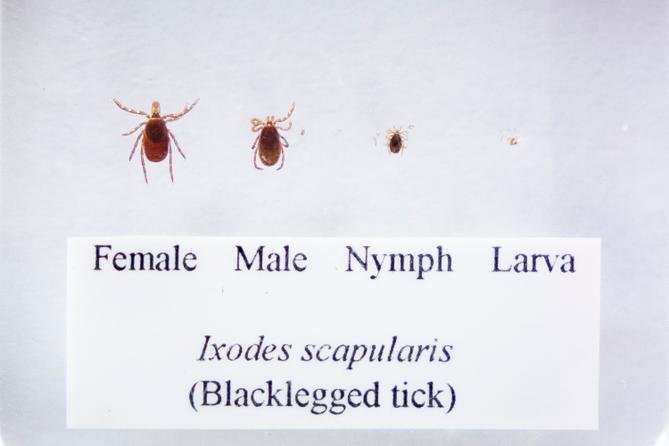This story was produced by the State College regional bureau of Spotlight PA, an independent, nonpartisan newsroom dedicated to investigative and public-service journalism for Pennsylvania. Sign up for our regional newsletter, Talk of the Town.
HOUSERVILLE — Pennsylvania leads the nation in Lyme disease cases, and the continued development of forested areas increases people’s risk of being bitten by the species of tick that transmits the illness.
When forests — where black-legged ticks thrive statewide — are fragmented to make room for roads, oil and gas sites, housing developments, or shopping centers, ticks have fewer available hosts and are more likely to bite humans.
The commonwealth had an estimated 16.6 million acres of forest land in 2019, according to the most recent data. That’s down from 16.9 million in 2014, with nearly half of the loss due to residential and commercial development. The western and eastern parts of the state saw the most forest land lost, reporting a 2% decline, and accounted for more than half of the state’s Lyme disease cases in 2022.
Environmental experts think more elected leaders should consider how forest fragmentation creates other risks, especially before greenlighting projects that come before local governing boards. And because tick season is getting longer due to warmer temperatures year-round, residents statewide are more vulnerable to contracting Lyme disease and other tick-borne illnesses.
“There’s no easy solution,” said Suzy Yetter, an ecologist with ClearWater Conservancy, an environmental group. “Because if you do one thing, you might increase the chance of something else, but thinking in terms of forest blocks, if your municipality has a huge section of forest, don’t develop that.”
Pennsylvania had the highest incidence rate of Lyme disease nationwide in 11 of the past 12 years, according to data from the Centers for Disease Control and Prevention.
The black-legged tick, also called a deer tick, is Pennsylvania’s most common species, and it is the only one that transmits Lyme disease when it feeds. The illness can cause flu-like symptoms and lead to more severe effects if left untreated. Black-legged ticks can also spread the Powassan virus, also called the deer tick virus, which attacks the central nervous system and can be fatal in extreme circumstances.
In 2022, Pennsylvania reported 8,413 confirmed Lyme disease cases, a number that has increased almost every year for more than a decade.
New Jersey and New York, which also consistently report high Lyme disease numbers, had nearly 5,900 and 2,018 cases last year, respectively.
Black-legged ticks love the humidity, shade, and cool and wet environments of forested areas, said Emily Struckhoff, a Penn State entomologist who studies tick-borne diseases and other illnesses.
Forests also provide an abundance of hosts for ticks to feed on, including deer, mice, chipmunks, birds, raccoons, and sometimes people. However, they can adapt to other climates, and when their preferred habitat is fragmented, tick populations don’t go down.
“It’s the opposite,” Struckhoff said.
When forests are cleared, ticks stay in place and gravitate to whatever hosts remain.
Since rodents also tend to be adaptable — Yetter described them as "habitat generalists" — they too stick around when forests are cleared, making them a prime host for ticks.
The white-footed mouse, which carries the Lyme disease bacteria and can live in fields and smaller tracts of trees, is one of the main ways that ticks come to harbor the disease.
And people come into contact with ticks in places they might not expect.
“I don’t think people are aware that they’re more likely to become infected by a tick in their backyard, walking their dog, working in their garden, than they are hiking in the woods,” Yetter said.
Rural communities should consider the effects of forest fragmentation before pursuing suburban-type developments, she added.
While development to increase housing and access to other essentials can’t be eliminated, Yetter suggested designating separate areas for pollinators and recreation in yards and public spaces to find a balance and mitigate the chance of interaction. She also called for increased state spending on tick-related research.
East Stroudsburg University’s Tick Research Lab conducts testing, partially funded by the state, for Lyme disease and other tick-borne illnesses. For Pennsylvania residents, it offers its services free and at reduced costs, depending on the type of testing panel. Earlier this year, the lab announced it was studying data from 30,000 tick exposures over three years to find ways to lower people’s chances of bites.
Nicole Chinnici, the laboratory director, told Spotlight PA that 50% of tick bites in Pennsylvania occur in backyards. It’s also not unusual for ticks to be active year-round as climate change leads to milder winters; they only need the temperature to be warmer than 45 degrees.
State Sen. Michele Brooks (R., Mercer) is one of the most vocal lawmakers pushing for enhanced tick surveillance. She’s introduced several bills related to testing, including one that would require local educators to notify parents if a tick was removed from their child during the school day.
Kids have the highest incidence rate for Lyme disease in the United States. Her legislation would require schools to preserve the tick and encourage schools or the child’s family to send it to the state’s tick testing lab.
Brooks has also proposed more testing and tracking efforts through collaboration with the state Department of Health and the tick lab and expanded medical coverage for Lyme disease treatment. “Telling people to wear socks and white clothing in the woods is not enough,” she said.
SUPPORT THIS JOURNALISM and help us reinvigorate local news in north-central Pennsylvania at spotlightpa.org/donate/statecollege. Spotlight PA is funded by foundations and readers like you who are committed to accountability and public-service journalism that gets results.

